Sue O'Connor FAHA FBA | |
|---|---|
| Alma mater | University of New England (Australia) (1980) University of Western Australia (1991) |
| Awards | Rhys Jones Medal for Outstanding Contribution to Australian Archaeology (2011) |
| Scientific career | |
| Fields | archaeology |
| Institutions | University of Western Australia Australian National University |
Sue O'Connor FAHA FBA is an Australian archaeologist and Distinguished Professor in the School of Culture, History & Language at the Australian National University. Her research focuses primarily on the evidence of Pleistocene settlement and early human migration in the Indo-Pacific region.
O'Connor studied archaeology at the University of New England (Australia) and graduated with honours in 1980. She furthered her studies at the University of Western Australia where she received her PhD in 1991. [1]
O'Connor was a lecturer at the University of Western Australia (UWA) from 1991 to 1994. In 1994, she accepted a research fellowship at Australian National University (ANU) in the Department of Archaeology and Natural History. In 2005, she was promoted to the Head of the Department and in 2008 was made a full Professor. [1]
O'Connor has conducted archaeological projects in the Northern Territory of Australia, Kimberley (Western Australia) Indonesia, Papua New Guinea and Timor Leste. Her research findings have demonstrated the first evidence of ancient people living in the Kimberley region over 40,000 years ago. Her investigations have also resulted in the earliest indication for rock art production in Australia [1]
O'Connor led a research expedition which discovered a cave site in East Timor, with evidence of people living more than 42,000 years ago. It is "the oldest evidence of occupation by modern humans on the islands that were the stepping stones from South-East Asia to Australia". Prior to O'Connor's research, scholars believed that early humans migrated south from Maritime Southeast Asia to Australia by traveling northwards by means of Borneo and Sulawesi, and then south through Papua New Guinea. With the new research findings, O'Connor believes that early humans traveled south from Maritime Southeast Asia through East Timor to Australia. [2]
O'Connor worked on a team that conducted research on a dog burial found at Matja Kuru in East Timor. Their findings suggest that humans domesticated dogs at the site as early as 3,000 years ago. Analysis of the remains revealed a number of morphological similarities between modern-day domesticated dogs and the dog found at the burial site. O'Connor and her team assert that the presence of domesticated dogs may indicate that a hunting-foraging way of life was still prevalent at the time. [3]
In 2017, O'Connor's research team recovered the world's oldest fish hooks from an ancient burial site on Alor Island, Indonesia. Five circular, rotating hooks, probably used for deep-sea fishing, were found under the chin and around the jaws of an adult female skeleton buried 12,000 years ago. This discovery contradicts the current theory that most fishing activities on the island had been carried out by men. Until 2017, the oldest fish-hooks found with a burial site were unearthed at a river site in Siberia and were determined to be 9,000 years old. [4]
In July 2024, O'Connor was elected as a Corresponding Fellow of the British Academy. [5]
Michael Parker Pearson, is an English archaeologist specialising in the study of the Neolithic British Isles, Madagascar and the archaeology of death and burial. A professor at the UCL Institute of Archaeology, he previously worked for 25 years as a professor at the University of Sheffield in England, and was the director of the Stonehenge Riverside Project. A prolific author, he has also written a variety of books on the subject.

Waigeo is an island in the Southwest Papua province of eastern Indonesia. The island is also known as Amberi or Waigiu. It is the largest of the four main islands in the Raja Ampat Islands archipelago, between Halmahera and about 65 kilometres to the northwest coast of New Guinea. The Dampier Strait separates it from Batanta, and the Bougainville Strait from the Kawe Islands to its northwest. The "inner sea" that nearly cleaves the island in two is Mayalibit Bay, also known as the Majoli Gulf.
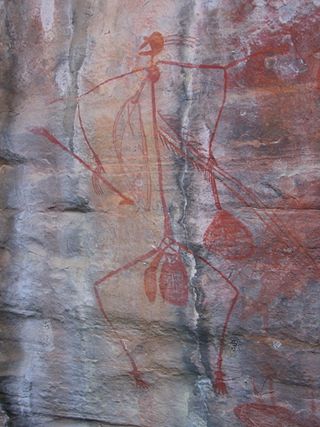
The prehistory of Australia is the period between the first human habitation of the Australian continent and the colonisation of Australia in 1788, which marks the start of consistent written documentation of Australia. This period has been variously estimated, with most evidence suggesting that it goes back between 50,000 and 65,000 years. This era is referred to as prehistory rather than history because knowledge of this time period does not derive from written documentation. However, some argue that Indigenous oral tradition should be accorded an equal status.
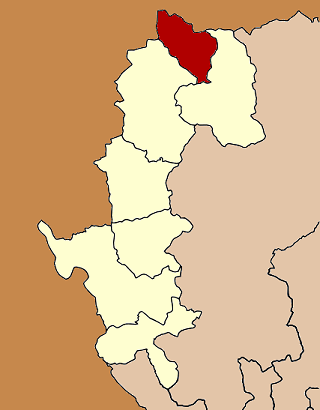
Spirit Cave is an archaeological site in Pang Mapha district, Mae Hong Son Province, northwestern Thailand. It was occupied 12,000 to 7,000 uncalibrated radiocarbon years ago by prehistoric humans of the Hoabinhian culture.

Ing'ombe Ilede is an archaeological site located on a hill near the confluence of the Zambezi and Lusitu rivers, near the town of Siavonga, in Zambia. Ing'ombe Ilede, meaning "a sleeping cow", received its name from a local baobab tree that is partially lying on the ground and resembles a sleeping cow from a distance. The site is thought to have been a small commercial state around the 16th century whose chief item of trade was salt. Ing'ombe Ilede received various goods from the hinterland of south-central Africa, such as, copper, slaves, gold and ivory. These items were exchanged with glass beads, cloth, cowrie shells from the Indian Ocean trade. The status of Ing'ombe Ilede as a trading center that connected different places in south-central Africa has made it a very important archaeological site in the region.

Raja Ampat, or the Four Kings, is an archipelago located off of the northwest tip of Bird's Head Peninsula, Southwest Papua province, Indonesia. It comprises over 1,500 small islands, cays, and shoals around the four main islands of Misool, Salawati, Batanta, and Waigeo, and the smaller island of Kofiau.
Peter Stafford Bellwood is Emeritus Professor of Archaeology in the School of Archaeology and Anthropology at the Australian National University (ANU) in Canberra. He is well known for his Out of Taiwan model regarding the spread of Austronesian languages.

Tutuala is a village and suco in the subdistrict of Tutuala. It is situated at the extreme eastern end of Timor. Its population at the 2004 census was 3,707. The subdistrict of Tutuala comprises two sucos, including Mehara and Tutuala with the subdistrict administrator residing in Tutuala. The suco of Tutuala comprised four hamlets (aldeia): Ioro, Pitileti, Tchailoro, and Vero. The main Fataluku language areas of the country are in Tutuala, as well as Lautem and Fuiloro.

The Lena Hara cave is the main cave of a system of solutional caves in the Lautém District at the eastern tip of East Timor (Timor-Leste), close to the village of Tutuala. Others are Ile Kére Kére and Jerimalai. Lene Hara has provided evidence that Timor has been occupied by humans since at least 35,000 years Before Present and thus is evidence that humans crossed the waters of Wallacea between the Pleistocene continents of Sunda and Sahul.
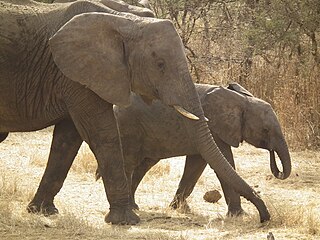
Swaga Swaga Game Reserve is a Tanzanian game reserve located in northwest Dodoma Region, that gives refuge to elephants and other vulnerable animals. It is located 50.6 miles from the city of Babati.
Jerimalai is a limestone cave southeast of Tutuala, on the eastern tip of East Timor. Fish remains and fish hooks excavated in Jerimalai provide evidence for advanced fishing technique by inhabitants of Timor 42,000 years ago.
Laili is a limestone cave located near the town of Laleia, Manatuto District, East Timor. Archeological findings in Laili provide evidence that the cave was occupied by modern humans 44,600 years ago, making it the second oldest known such habitation in Wallacea aside from Madjedbebe in mainland Northern Australia.
Mán Bạc is a Neolithic archaeological site located in Yên Mô District, Ninh Bình Province, Vietnam, dated from around 1,850–1,650 BC. Mán Bạc is associated with the Phùng Nguyên culture. With 95 burials found at the site, Mán Bạc is the largest and most intact site associated with the Phùng Nguyên culture, surpassing the site at Lung Hoa.
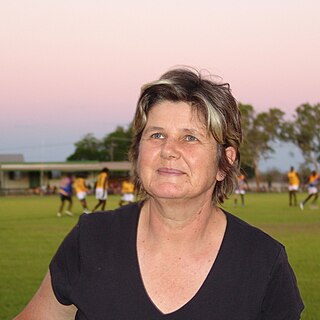
Jane Balme is a Professor of Archaeology at the University of Western Australia. She is an expert on early Indigenous groups and Australian archaeology.
Alison Weisskopf (1960–2018) was a British-German archaeologist specialising in archaeobotany, specifically the analysis of ancient phytoliths.

The Hyde Park pet cemetery is a disused burial ground for animals in Hyde Park, London. It was established in 1880 or 1881 in the garden of Victoria Lodge, home of one of the park keepers. The cemetery became popular after the burial of a dog belonging to Sarah Fairbrother, wife of Prince George, Duke of Cambridge. Some 1,000 burials were carried out before the cemetery was generally closed in 1903; sporadic burials were carried out thereafter until 1976. Most of the animals are dogs, though some cats, monkeys and birds were also buried. The site is owned by the charity The Royal Parks and not open to the public except as part of occasional tours.

The Toalean people were hunter-gatherers who inhabited the Indonesian island of Sulawesi during the Mid- to Late-Holocene period prior to the spread of Austronesian Neolithic farmers some 3,500 years ago from mainland Asia.
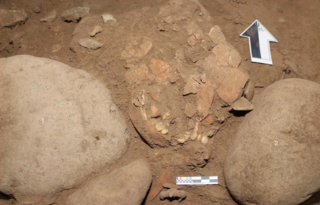
Besséʼ is the prehistoric fossil of a young woman over 7,200 years old found in the Indonesian island of Sulawesi. Discovered at Leang Panninge at the Maros Regency by archaeologists from the University of Hasanuddin in 2015, its formal description including genome sequencing was published in Nature in 2021. As the first human remain discovered belonging to the Toalean people, it provides critical understanding to human culture and migration during the Holocene period of Asia. The nickname is adopted from the Bugis's custom of affectionately calling their newborn baby girls.
Ronika K. Power is an Australian archaeologist who is a Professor of Bioarchaeology in the Department of History and Archaeology and Director of the Centre for Ancient Cultural Heritage and Environment at Macquarie University. Power is a Fellow of the Society of Antiquaries of London and the Royal Society of New South Wales.
In the archaeology of Maritime Southeast Asia, the Metal Age is the period between roughly 2000 and 500 years ago. The internal chronology of the period is still debated, but it is often divided into 'early', 'developed' and 'proto-historic' phases. Unlike in the conventional three-age system used in other parts of Eurasia, archaeologists do not divide the Metal Age into a Bronze Age and Iron Age, because bronze and iron metallurgy arrived in Maritime Southeast Asia at roughly the same time.